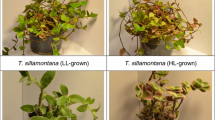Summary
The capacity of adaptation and the range of adjustment to different light conditions in fully expanded mutant leaves were studied on an aurea variety of privet (Ligustrum ovalifolium Hassk. var.aureum). Whenever the light conditions are altered leaves respond immediately. Although adaptational changes in leaf thickness are not possible, the change in colour, as well as changes in pigment concentrations take place within several days. With increasing light intensity there is a marked decline in chlorophyll concentration and the carotenoid yield becomes much higher. Under low light conditions the chlorophyll content is high, while the carotenoid concentration drops significantly.
The mutant chloroplasts from green leaves always have a well developed thylakoid system. The only difference between young green leaves (DG1) and older regreened ones (DG2) is in the number of thylakoids per granum (grana in older leaves consist of more thylakoids), while the stacking degree of thylakoids remains about the same (74 and 77% respectively). Depending on the previous light conditions fine structure of plastids in yellow leaves differs considerably. Young yellow leaves (Y0) contain plastids with longitudinal arrays of dilated thylakoids and prothylakoid bodies occasionally. Plastids from primarily green leaves which turned yellow afterwards in strong sunlight (Y1) are characterized by thylakoids densely packed into cup-shaped stacks, or large vesicles originating from dilated thylakoids. The stacking degree of thylakoids in sun exposed yellow leaves (determined only in Y0 leaves) is extremely low and reaches only 29%.
Similar content being viewed by others
References
Bauer, A., 1956: Beiträge zur Pigmentphysiologie der Blätter vonAurea-Varietäten. Beitr. Biol. Pfl.32, 403–426.
Boardman, N. K., 1977: Comparative photosynthesis of sun and shade plants. Ann. Rev. Plant Physiol.28, 355–377.
Holden, M., 1965: Chlorophylls. In: Chemistry and biochemistry of plant pigments (Goodwin, T. W., ed.), pp. 461–468. London-New York: Academic Press.
Hopkins, W. G., Hayden, D. B., Neuffer, M. G., 1980 a: A light sensitive mutant in maize (Zea mays L.). I. Chlorophyll, chlorophyll-protein and ultrastructural studies. Z. Pflanzenphysiol.99, 417–426.
Hopkins, W. G., German, J. B., Hayden, D. B., 1980b: A light sensitive mutant in maize (Zea mays L.) II. Photosynthetic properties. Z. Pflanzenphysiol.100, 15–24.
Kunst, L., 1983: Plastid development in leaves ofLigustrum ovalifolium Hassk. var.aureum at high and low light conditions. Acta Bot. Croat.42, 29–36.
Lichtenthaler, H. K., Kuhn, G., Prenzel, U., Buschmann, C., Meier, D., 1982: Adaptation of chloroplast ultrastructure and of chlorophyll-protein levels to high-light and low-light growth conditions. Z. Naturforsch.37 c, 464–475.
—,Buschmann, C., Döll, M., Fietz, H.-J., Bach, T., Kozel, U., Meier, D., Rahmsdorf, U., 1981: Photosynthetic activity, chloroplast ultrastructure, and leaf characteristics of high-light and low-light plants and of sun and shade leaves. Photosynthesis Res.2, 115–141.
Meier, D., Lichtenthaler, H. K., 1981: Ultrastructural development of chloroplasts in radish seedlings grown at high and low light conditions and in the presence of the herbicide bentazon. Protoplasma107, 195–207.
Reynolds, E. S., 1963: The use of lead citrate at high pH as an electron-opaque stain in electron microscopy. J. Cell Biol.17, 208–212.
Schmid, G. H., 1967: The influence of different light intensities on the growth of the tobacco aurea mutant Su/su. Planta77, 77–94.
—,Price, J. M., Gaffron, H., 1966: Lamellar structure in chlorophyll deficient but normally active chloroplasts. J. Microscopie5, 205–212.
Seybold, A., Egle, K., 1938: Lichtfeld und Blattstoffe. II. Planta38, 87–123.
Urbach, W., Rupp, W., Sturm, H., 1976: Experimente zur Stoffwechselphysiologie der Pflanzen, p. 96. Stuttgart: G. Thieme.
Willstätter, R., Stoll, A., 1918: Untersuchungen über die Assimilation der Kohlensäure, pp. 41–171. Berlin: Springer.
Wrischer, M., Ljubešić, N., Devidé, Z., 1975 a: Transformation of plastids in the leaves ofAcer negundo L. var.Odessanum (H. Rothe). J. Cell Sci.18, 509–518.
— — —, 1975 b: Ultrastructural studies of plastids in leaves ofFraxinus excelsior L. var.aurea (Willd). J. Microscopie Biol. Cell.23, 105–112.
— — —, 1976: Ultrastructural and functional characteristics of plastids in the leaves ofLigustrum ovalifolium Hassk. var.aureum. Acta Bot. Croat.35, 57–64.
Author information
Authors and Affiliations
Rights and permissions
About this article
Cite this article
Kunst, L., Wrischer, M. Adaptational changes of plastids in the leaves ofLigustrum ovalifolium Hassk. var.aureum at different light intensities. Protoplasma 122, 132–137 (1984). https://doi.org/10.1007/BF01279446
Received:
Accepted:
Issue Date:
DOI: https://doi.org/10.1007/BF01279446




